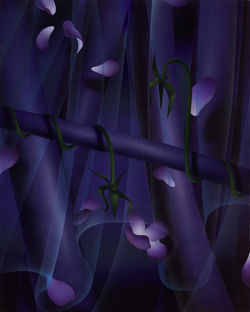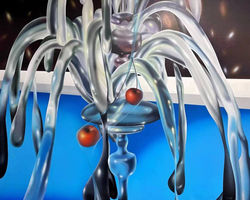Tang Contemporary Art is pleased to announce the opening of artist Hou Jianan’s solo exhibition Picnic at our Beijing Headquarters Space on July 8th, 2023. The exhibition will present more than 20 new pieces of work by the artist.
Activities in the style of “picnics” had already emerged in notable works by ancient Greek and Roman writers such as Ovid, Plutarch and Seneca. It also appears in many Chinese poems and historic records. However, the word “picnic” is a product of the contemporary. The picnic in a modern sense first developed in 17th century France, with its origin being the French word “Pique-Nique”. French nobility later brought this new method of recreation to Britain, where it grew into the modern word “picnic”. The new chapter of “picnics” was accompanied by important historic changes such as the Industrial Revolution and the Enclosure Movement. They catalyzed the rapid expansion of cities, resulted in teeming industries and a multitude of towering chimneys. This then led to the swelling of the working class. The success of the Industrial Revolution and expansions of oversees colonies produced a number of rising urban and petty bourgeoisie groups. Escape from cities and return to the countryside has in turn become the hot topic at the time, the new trend that swept across Europe. In 1863, Manet completed his well-known work The Luncheon on the Grass, which exhibited vividly the more challenging methods of depicting a picnic scene. It was an experience frozen in historic episodes.
Returning to the theme of “picnic” displayed in Hou Jianan’s new works. Ubiquitous advertising and social media have alienated the picnic into a performative activity. Hou believes that the picnic culture has become a miniature version of the spectacle society. Although scenery is a type of image, it still attempts to obscure the signs of said alienation. In Hou’s works, such alienation has been successfully built up as a dissociation from real-life experiences. Here, the artist uses the more typical way of painting to emphasize the official tone of disengagement, viewing “picnic” as a method of redefining and exploring identity recognition. Today, our consumption-based social interactions are mostly established upon consumer and material culture. The picnic, as a simpler and more natural way of life, provides us a opportunity to reflect and contemplate on the sense of identity.
In Symbolic Power and Social Order, Lyotard suggested a kind of symbology theory that discussed the meaning of symbols and the rules of their usage. It also dives into the role of said activities within the functioning of social order. The consumer society’s rapidly replaced commodities, such as fresh flowers, fruits and candles, are evidently shown in Hou Jianan’s works. They shaped a ceremony/landscape that satisfies the fleeting delights of the masses, while also making observations and retrospections on consumer society and virtual space. Invisible forces that engulf society, such as cognitively refreshing waves of information, surface-level scans and frenzied desires, are transformed into a mesmerizing jungle that uses its bright and beautiful facade to conceal its numerous traps and pitfalls. Simultaneously, the above-mentioned symbolic objects are utilized to generate new materialistic relationships and societal layouts.
Hou Jianan does not insist on methods of treatment such as touch, texture, shading and form in his creations, he uses modelling tools to gain the desired source material, then enrich the monotony of digital color using layered acrylics, hence the most ordinary scenes become fluid and anamorphic, manifesting a strong allegory of the costs of image conversion. This mannered self-landscaping displays a sense of dilation and craving, with scenes taking shape as the artist plays the role of administrator. This making of illusions rekindled the attention on the correlation between image and human experiences, thus image and the stimulated audience become interlinked. Scenery is a resurrected desolation once filled with decay and debris, as dark currents drift through the meretricious splendor, fading in and out of the straying and swaying candlelight.
Fiona Lu
 Wind-catching Trap NetAcrylic on canvas 120 × 150 cm 2022 |  Wave Stealing Sea WaterAcrylic on canvas 80 × 60 cm 2023 |  The Tree Upstream#3Acrylic on canvas 100 × 80 cm 2023 |
|---|---|---|
 The Tree Upstream#2Acrylic on canvas 100 × 80 cm 2023 |  The Tree UpstreamAcrylic on canvas 140 × 110 cm 2022 - 2023 |  The Ceremony does not LieAcrylic on canvas 180 × 150 cm 2023 |
 The Beach will Fulfill Your Wish#2Acrylic on canvas 60 × 50 cm 2023 |  Sceneries: The Fair and Foul#2Acrylic on canvas 200 × 160 cm 2022 - 2023 |  Sceneries: The Fair and FoulAcrylic on canvas 200 × 160 cm 2023 |
 The Beach will Fulfill Your WishAcrylic on canvas 60 × 50 cm 2023 |  Rite of the Flower HeistAcrylic on canvas 100 × 80 cm 2023 |  Natural TrapAcrylic on canvas 160 × 200 cm 2022 |
 Life of Boredom after DinnerAcrylic on canvas 185 × 250 cm 2023 |  Fleeting ShadowAcrylic on canvas 120 × 150 cm 2022 |  Fallen Blooms of the Future Stays in the FutureAcrylic on canvas 185 × 250 cm 2023 |
 Evening BreezeAcrylic on canvas 230 × 180 cm 2023 |  ActingAcrylic on canvas 185 × 250 cm 2023 |  Artificial PicnicAcrylic on canvas 160 × 200 cm 2022 |
 Emotion measured in SecondsAcrylic on canvas 150 × 120 cm 2022 |  Apple SnareAcrylic on canvas 120 × 150 cm 2022 |  Defining DecayAcrylic on canvas 60 × 50 cm 2023 |
Artist

Hou Jianan
Hou Jianan, born in 1992 in Yanbian, Jilin, graduated from Sichuan Fine Arts Institute in 2014 with an undergraduate degree in oil painting, and graduated from Sichuan Fine Arts Institute in 2018 with a postgraduate degree in oil painting, and now lives and works in Chongqing.
Hou Jianan is good at coming up with concepts and treats painting as a tool to serve the concept rather than an end. Therefore, he will not force on the details of painting such as hand, texture, light and dark, and form. He will use modeling software to get some desired materials, use superimposed acrylics to dissolve the monotony of digital colors, and make the most everyday scenes smooth and distorted, reflecting a sense of expansion and desire. The artist plays the role of a manager in the world he creates, using it as a tone to build the picture.
Hou Jianan also specializes in creating fictional stories as the main vein, and his works are mostly in the form of Pop, showing the sense of fast food, consumption and entertainment rushes, coming from the artist's keen intuition "This kind of image with a sense of stretching is like the ever-expanding desire nowadays." He sensitively captures the experience of visual excess brought to the younger generation by the virtual feast of the Internet, and the characteristics of the virtual era become an important theme for the artist to portray. The fictitious picture environment is filled with inflated and gorgeous virtual visual scenes, conveying the seemingly gorgeous but fragile experience of Internet iconography in a specific time and space, presenting the young generation's observation and reflection on modern society and popular culture.
His important solo exhibitions include: Don't Walk Meekly into the Forest (ArtDepot Art Warehouse, Beijing), Clockwork Illusion (ArtDepot Art Warehouse, Beijing), and The McDonald's Project - Right Graffiti Play (ArtDepot Art Warehouse, Beijing); he has participated in important group exhibitions including: Express Vol.2 (Changting Gallery, Tokyo), Post-Me Generation-How to Write Young Artists (Tang Contemporary Art Center, Beijing), Moderately Sweet (Tong Gallery+Projects, Beijing), Me and My Fugue (ArtDepot Art Warehouse, Chongqing), Tide Pole Players ( Times Art Museum, Beijing), etc. Hou Jianan's works have also been exhibited at many major art fairs such as Felix Art Fair, Los Angeles, Art021, Shanghai, T Art-Con, FINEART ASIA, Hong Kong, and Art Shenzhen.
